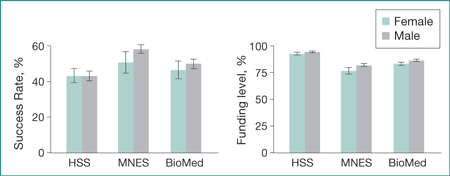Abstract
Gender Bias in Funding of Proposals Submitted to the Swiss National Science Foundation
François Delavy,1 Anne Jorstad,1 Matthias Egger1
Objective
The Swiss National Science Foundation is the largest public research funder in Switzerland. Its Research Council assesses proposals and makes funding decisions. Proposals can be subject to budget cuts. Our objective was to investigate whether success rates and cuts in budgets differed between male and female applicants.
Design
We analyzed the decisions for proposals submitted from 2014 to 2016. We computed average success rates and funding levels (yearly approved amount of funding divided by yearly requested amount of funding) by gender and domain of research: Humanities and Social Sciences (HSS), Mathematics, Natural and Engineering Sciences (MNES); and Biology and Medicine (BioMed). Funded projects received a mean annual support of 140,000 CHF (~144,000 USD). We performed 2 regression analyses to adjust for potential confounders, including submission year and characteristics of the applicants (affiliation, discipline, age, nationality, first-time applicants): a logistic regression for success on all proposals (n=5687) and a linear regression for funding level on approved proposals (n=2824).
Results
The average success rate of female applicants was similar to male applicants in HSS, but 7.8% lower in MNES and 3.5% lower in BioMed (Figure). In the multivariable logistic regression model the odds of approval continued to be lower for proposals submitted by women in MNES (odds ratio compared with men, 0.72 [95% CI, 0.54-0.96]); but not for HSS (95% CI, 0.77-1.15) and BioMed (95% CI, 0.77-1.25). Furthermore, the budgets of proposals from female applicants were cut more substantially than the budgets of male applicants. Funding levels were 2.7% lower in HSS, 5.7% lower in MNES, and 3.2% lower in BioMed in female compared with male applicants. In the multivariable linear regression model, the funding level was 2.5% (95% CI, 0.3%-4.6%), 6.0% (95% CI, 2.3%-9.7%), and 3.6% (95% CI, 0.9%-6.0%) lower for female compared with male applicants in domains HSS, MNES, and BioMed, respectively.
Figure. Success Rate and Funding Level by Research Domain and Gender
HSS Indicates humanities and social sciences; MNES, mathematics, natural and engineering sciences; BioMed, biology and medicine.
Conclusions
Proposals from female applicants had lower success rates in MNES, BioMed, and differences persisted in models adjusted for potential confounding factors in MNES. Furthermore, budget cuts were more substantial for female than for male applicants in all domains, and differences again persisted in adjusted analyses. These results are compatible with a gender bias but cannot prove the existence of such bias.
1Swiss National Science Foundation, Bern, Switzerland, francois.delavy@snf.ch
Conflict of Interest Disclosures:
None reported.

